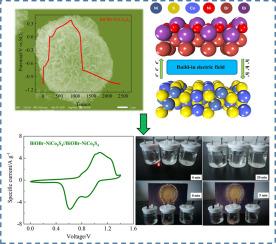在超级电容器碱性电解质中构建具有宽电位窗的BiOBr-NiCo2S4复合材料
IF 5.7
3区 材料科学
Q2 MATERIALS SCIENCE, MULTIDISCIPLINARY
引用次数: 0
摘要
具有广泛电势范围的复合材料的发展对提高比能的超级电容器的发展至关重要。在这项工作中,合成了BiOBr-NiCo2S4复合材料,并在-1.2 ~ 0.4 V的电位窗口内提供了1280 C g-1的突出比容量。组装了电压为1.4 V的bibr - nico2s4 //BiOBr-NiCo2S4对称液体电容器,其比能量为40.25 Wh kg-1,比功率为0.7 kW kg-1。从能带和电子态密度的角度,运用密度泛函理论(DFT)讨论了bibr - nico2s4优异的电容性能。可以推测,BiOBr-NiCo2S4复合材料内部产生了协同效应,从而使BiOBr-NiCo2S4复合材料具有出色的速率性能。该研究为设计具有高比容量和宽电位范围的电极材料提供了有价值的见解。本文章由计算机程序翻译,如有差异,请以英文原文为准。

Constructing BiOBr-NiCo2S4 composite with broadened potential window in alkaline electrolytes for supercapacitors
The development of composite materials with extensive potential range is pivotal for the advancement of supercapacitors with elevated specific energy. In this work, BiOBr-NiCo2S4 composite was synthesized and supplied a prominent specific capacity of 1280 C g-1 across a potential window of -1.2 ∼ 0.4 V vs. SCE. A symmetrical liquid capacitor of BiOBr-NiCo2S4//BiOBr-NiCo2S4 with a voltage of 1.4 V is assembled, which can deliver an impressive specific energy of 40.25 Wh kg-1 at a specific power of 0.7 kW kg-1 . From the perspectives of energy band and density of electronic states, the density functional theory (DFT) is employed to discuss the outstanding capacitance performance of BiOBr-NiCo2S4. It is presumed that an synergistic effect generated within the BiOBr-NiCo2S4 composite, thereby endowing the BiOBr-NiCo2S4 composite with outstanding rate performance. This research provides valuable insights for design the electrode materials that possess high specific capacity and broad potential range.
求助全文
通过发布文献求助,成功后即可免费获取论文全文。
去求助
来源期刊

Materials Research Bulletin
工程技术-材料科学:综合
CiteScore
9.80
自引率
5.60%
发文量
372
审稿时长
42 days
期刊介绍:
Materials Research Bulletin is an international journal reporting high-impact research on processing-structure-property relationships in functional materials and nanomaterials with interesting electronic, magnetic, optical, thermal, mechanical or catalytic properties. Papers purely on thermodynamics or theoretical calculations (e.g., density functional theory) do not fall within the scope of the journal unless they also demonstrate a clear link to physical properties. Topics covered include functional materials (e.g., dielectrics, pyroelectrics, piezoelectrics, ferroelectrics, relaxors, thermoelectrics, etc.); electrochemistry and solid-state ionics (e.g., photovoltaics, batteries, sensors, and fuel cells); nanomaterials, graphene, and nanocomposites; luminescence and photocatalysis; crystal-structure and defect-structure analysis; novel electronics; non-crystalline solids; flexible electronics; protein-material interactions; and polymeric ion-exchange membranes.
 求助内容:
求助内容: 应助结果提醒方式:
应助结果提醒方式:


